They say… 
Best beer and travel writing award 2015, 2011 -- British Guild of Beer Writers Awards
Accredited Beer Sommelier
Writer of "Probably the best book about beer in London" - Londonist
"A necessity if you're a beer geek travelling to London town" - Beer Advocate
"A joy to read" - Roger Protz
"Very authoritative" - Tim Webb.
"One of the top beer writers in the UK" - Mark Dredge.
"A beer guru" - Popbitch.

|
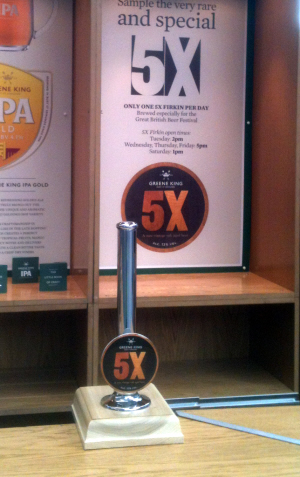 The unlikely handpump that lured the bloggerati — Greene King Old 5X on cask at the Great British Beer Festival, London, August 2012. Top Tastings 2012
ABV: 12%
Origin: Bury St Edmunds, Suffolk, England
Website: www.greeneking.co.uk
It has to be admitted that these days the Greene King bar is rarely the hottest place to be at a beer festival. Yet at the Great British Beer Festival (GBBF) at Olympia, London, in August 2012, that expectation was turned on its head.
At an appointed time in the early afternoon of the first day’s trade session, many of the most influential beer opinion formers in Britain could be found gathering around the Suffolk brewer’s bar – top beer writers, widely read bloggers, international beer judges and various other industry figures.
And no, they hadn’t all suddenly undergone a mysterious conversion to the delights of Greene King IPA. Instead they were there for the GBBF debut of one of the most extraordinary beers brewed by an old established British cask ale brewery. The beer was Old 5X, a unique matured stock ale that has miraculously survived in an era when its brewer has become the biggest of Britain’s “new nationals”.
I’ve written about Old 5X at length before on this blog – but this was before I had a chance to taste it neat, as until very recently it was only made publically available as a component of blends. At 12% it’s strong stuff, brewed with roasted malt and rich cane sugar, with Challenger, First Gold and Target hops, but what’s more remarkable is the process used to produce it.
Following primary fermentation it’s matured for at least a year in two old oak vats holding 100 barrels (16,366l) each, retained by the brewery for the purpose, before being blended with younger beer for release. For years it’s been mixed with Burton Pale Ale, another beer not allowed out on its own, to make bottled speciality Strong Suffolk, and more recently it’s emerged in Old Crafty Hen.
Long maturation and blending were once common in brewing – at a certain stage in its history, porter was a blend of wood matured beer which had become flat and vinous, or “stale” as it was once termed, with young “mild” or “running” beer. Inevitably, wild yeasts and other microflora resident in the wood contributed a certain character and complexity, and often a sour or funky note, to vatted beer.
Before such practices were revived in the more experimental corners of the contemporary craft beer world, Greene King was the only British brewery at which they clung on, though like so many quirky old techniques they could be encountered more readily in Belgium. West Flemish oud bruin, once an everyday quencher in its region of origin and now a prized speciality, is brewed in a similar way, and the huge oak foeders still in use at Rodenbach in Roeselare bear obvious resemblance to GK’s vats.
GK long resisted suggestions from beer lovers to make Old 5X more widely available in its own right, insisting that nobody would want to drink it – widely interpreted as yet another sign of how out of touch the Bury St Edmunds brewery was with the way the specialist beer market is developing, and perhaps how dedicated it had become to the pursuit of blandness in the name of palatability.
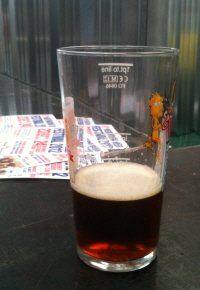 Cask Greene King Old 5X So what changed the brewery’s mind? Apparently a long serving local CAMRA volunteer was due to retire and head brewer John Bexon suggested creating a special beer for him at the East Anglian Beer Festival, held at Bury. Instead the volunteer requested a cask of Old 5X. Contrary to John’s expectations, the cask rapidly sold out, prompting the brewery to repeat the experiment.
The cask version at GBBF, available as a limited edition of one nine gallon firkin (41l) a day, was a year-old ale kräusened with fresh beer. Served by the third pint (197ml) nip, it poured a hazy rich reddish brown with a thick yellow head. The aroma was beautifully full, rich and very fresh with chocolate and orange peel notes, and just a hint of sourish balsamic vinegar.
The palate was sherry-sweet, nicely matured and, to me, utterly luxurious, again with just a slight funky sweet-sour touch, almonds and citrus. The big, orangey and nuttily malty finish wasn’t quite as long as expected, but amazingly rounded for the strength.
I spoke to John at GBBF and he still seemed bemused, though pleased, with the interest in the beer. Let’s hope it prompts further releases, and perhaps a special edition bottle conditioned version.
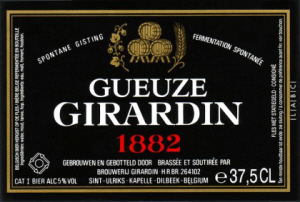 Gueuze Girardin 1882 (Zwart etiket) Top Tastings 2012
ABV: 5%
Origin: Sint-Ulriks-Kapelle, Vlaams-Brabant, Vlaanderen
Website: www.brouwerijgirardin.com
Girardin is arguably the most consistently and rootedly traditional of all the lambic breweries. The others were either founded since the self conscious revivalism of the 1970s or, like Cantillon, heavily influenced by it – or at the other extreme pursued the commercial path towards the fruit syrup bottle and the aspartame jar.
Instead what we have at Sint-Ulriks-Kapelle is something pretty close to the traditional independent farmhouse lambic brewery the Girardin family first took over in 1882 – the date that still appears on the bottles. The family remains in charge, still producing a simple and limited range: a filtered and unfiltered geuze, a faro, a kriek and a framboise.
Throughout, the brewery has also continued to make its unblended lambic widely available to pubs, geuzestekerijen (independent blenders) and other brewers. This policy alone has got many a revivalist out of a difficult spot, and in the process made a major contribution to the continued health of lambic culture.
Girardin’s unfiltered geuze doesn’t carry the recent Oude Gueuze appelation, though this is nonetheless what it is. Instead it’s identified by the black colour of the simple, classic label (zwart etiket or étiquette noire), as opposed to the white label of the filtered version. It’s the sort of beer that I don’t drink often enough, but I picked up a 375ml bottle at the London Drinker beer festival in March 2012 and reminded myself of how great it is.
This pale gold beer has a warm orange glow, topped by an unusually persistent fine white head. The characteristic pippy, funky lambic aroma has fruit and citrus peel, with hints of mastic.
The fine and very well integrated palate yields grapefruit pith and lemon marmalade, with slight sweetness offsetting a thick, petrolly lambic smack. There are elusive herbal notes on an apple core and marmalade finish.
Tim Webb, the leading writer on Belgian beer, says he uses this geuze to demonstrate to the unitiated what lambic is all about. You can see why – the beer is properly, authentically tart, but not severely so, and an excellent example of its kind.
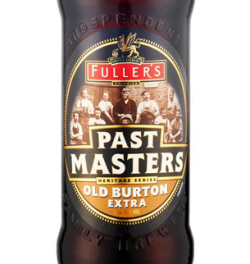 Fuller’s Past Masters Old Burton Extra Top Tastings 2012
ABV: 7.3%
Origin: London W4, England
Website: www.fullers.co.uk
Burton Ale is one of the great near-lost beer styles, and one that has intrigued certain beer writers (including myself) thanks in part to its difficult to explain contemporary obscurity. Most beer enthusiasts who read the occasional book or blog can tell you a (not necessarily accurate) thing or two about the history of porter or India pale ale, and if you mention Burton will probably assume the latter.
But in fact Burton ale was a distinctive style on its own account, different from pale ale. Although it originated or was perfected in the great brewing centre of Burton upon Trent, Staffordshire, in the days before the regulation of designations of origin it became a generic term for beers in the style wherever they were brewed. And it remained widely consumed right into the 1950s as what beer historian Martyn Cornell describes as “one of the three most popular draught beer styles in Britain” – by then more appreciated in London than in its Midlands homeland.
Burton was a dark, sweetish beer already around before pale ale took off in the town, originally made from brown malt in the days before pale malts became widespread and affordable. Like most beers it was later modified to fit the now ubiquitous practice of basing beer recipes on pale malt, with additions of coloured and speciality malts as required. It therefore became paler in colour, though still brown, giving rise to the confusing term Burton Pale Ale (BPA) – pale in comparison to the old brown malt version but still notably darker than the beers we now think of as pale ales.
Like porter, Burton was originally made in a variety of strengths, including very strong versions which at one point were widely exported, but by the time the first stages of the current beer revival kicked off in the 1970s, it had fallen from favour so comprehensively it was near-completely forgotten. It didn’t help that the few remaining Burtons to survive now hid under other names.
The most familiar is Young’s Winter Warmer, a cask London Burton of moderate strength renamed in 1971 and still regularly brewed today as a tasty seasonal by Wells & Young’s. A BPA is also one of the components of Greene King’s blended bottled speciality Strong Suffolk but hasn’t been sold in its own right for decades.
Only in the past few years has the history of Burton Ale been rediscovered, though revivalist experiments remain rare even among brewers who make a habit of such things. It was particularly exciting, then, when John Keeling announced he was dusting down a 1931 Burton recipe for the third entry in Fuller’s Past Masters series of revived beers from the archive.
Old Burton Extra is a relatively strong version of the style at 7.2%, made from pale and crystal barley malts boosted by maize and brewing syrup. The hops are a traditional combination of English Fuggles and Goldings used both in the copper and to dry hop the beer.
The result is a rich deep Burgundy brown with a thick yellow beige head. There’s sultana and chocolate on a rich, smooth, malty and slightly spicy aroma with honey, black grape and a subtle hint of violet.
A thick, cakey and very fruity palate dries rapidly, revealing roasted notes over a treacle base with spicy orange around the edges. A charred dry finish has an almost iron-like quality, with more chocolate, cake and spice.
Given its historical interest, I was particularly eager to try this beer when the taster sample arrived from the brewery, and I wasn’t’ disappointed. A wonderfully rich bottleful that’s also beautifully poised, this is a very welcome revival, and if it contributes to the growth of interest in the style, all the better.
 FiftyFifty Eclipse Imperial Stout 2011, white wax version Top Tastings 2012
ABV: 9.5%
Origin: Truckee, California, USA
Website: www.fiftyfiftybrewing.com
Craft brewers, particularly in the United States, are increasingly recognising the potential for “event beers” and limited editions in capturing the growing market of beer connoisseurs prepared to pay over the odds for something a bit rare and special. There’s an obvious temptation towards cynical exploitation in this, resisted so long as the quality of the contents lives up to the hype and the restricted supply.
Based on a recent tasting, one brewery reliably ensuring that all the fuss – and the cash – is worthwhile is FiftyFifty at Truckee, not far from the state line in Nevada County, northeast California. FiftyFifty is also a brewpub and restaurant producing a range of beers from the sessionable to the challenging but is best known beyond its own locale for the Eclipse range of barrel aged imperial stouts.
Brewer Todd Ashman was one of the earliest US champions of barrel ageing at his previous brewery, Flossmoor Station in Illinois, and was instrumental in persuading the Brewers Association to recognise such beers as a competition category in their own right in the early 2000s.
His first experiments in ageing FiftyFifty’s award winning Totality Imperial Stout to create Eclipse were in 2007 and since then approaching 30 different expressions have emerged.
Totality is already a complex brew, with more than 18 separate ingredients. The grain bill alone contains various pale, coloured, Munich, chocolate, brown and black malts from Crisp, Gambrinus, Rahr and Simpsons, red wheat malt and roasted barley, plus dry malt extract, brown rice syrup solids and exotic sugars. Besides this, the hops seem relatively straightforward – German Magnum and Perle and US Mount Hood.
The stout is brewed and conditioned in March or April and put into barrels in May, with bottling and kegging taking place in November for a December release. To add to the mystique, beers from different barrels are packaged in identical 650ml bomber bottles, but sealed with different coloured wax to indicate their provenance, with a key on the brewery website.
Healthy Spirits in San Francisco’s Dubose Triangle is a regular outlet and I found several 2011 vintages on sale there in October 2012 – I was particularly recommended the white wax version, which had spent six months in Elijah Craig 20-year-old bourbon barrels (that particular whiskey is not regularly released as a 20-year-old so this particular barrel was itself a rarity).
This was a very dark mahogany coloured beer that left oily yellow iodine-like traces on the glass, with a deep tan foam. A smooth and inky aroma had raisin and berry fruit, dark malt and woody whisky fumes.
There was plenty of fruity, oily sweet bourbon-tinged malt on the full, smooth, lightly honeyed palate, which warmed and dried out in the mouth with woody tannins softened by raisins and chocolate.
The sweet black coffee finish was very long with delicate wood notes and late cigar ash. Overall, this was an amazingly complex but well integrated, long lasting and delightful beer that amply evidenced the care spent on it.
At $28.99 (£19, €22.30) the price might seem steep, but as always it’s worth remembering what you’d expect to pay for a wine of such quality.
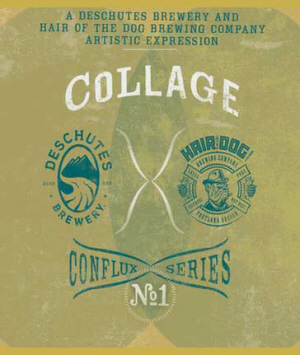 Deschutes / Hair of the Dog Conflux No 1 — Collage Top Tastings 2012
ABV: 11.6%
Origin: Bend, Oregon, USA
Website: www.deschutesbrewery.com, www.hairofthedog.com
Two of the best known and highest achieving craft breweries in the general vicinity of Portland, Oregon, got together to produce this long anticipated collaboration beer. Over two years in the making, it became the first of the new Conflux series of collaborations overseen by Deschutes, now one of the US’s bigger craft breweries.
The Bend-based brewery’s bread and butter is the easy going pale ale Mirror Pond, one of the top ten best selling craft beers in the US, but it retains credibility among the cognoscenti with a highly rated range of specials, experimental and extreme beers. Among the most celebrated are The Dissident, a hyped-up take on a Flemish oud bruin infused with brettanomyces and matured in wine barrels, and The Stoic, a strong but conventionally fermented abbey-style beer with pomegranate that’s also barrel matured.
Hair of the Dog in Portland is smaller and more specialised, admired for strong and curious hybrids and obscure historical revivals created by brewer Alan Sprints, who founded the company in 1993. Alan’s first beer was Adam, a recreation of a defunct beer style from Dortmund rediscovered by local beer writer and historian Fred Eckhardt, whom Alan then honoured with a distinctive Belgian-inflected barley wine named Fred.
In Spring 2012, Alan got together with Deschutes founder Gary Fish to brew special batches of all four beers at the latter’s brewery in Bend. These were then aged for two years in a wide variety of different casks – refill rye whiskey, cognac, sherry, pinot noir, bourbon and new American and Oregon oak – to produce around 100 distinct beers which were then used to create a final blend. The limited edition of only 200 barrels (235hl) was released in May 2012.
I have to admit to a growing cynicism about well-publicised collaborations that seem designed primarily to push obsessive beer geeks’ buttons, but my admiration for both breweries overcame this when I saw the beer listed at upmarket San Francisco beer restaurant the Abbot’s Cellar in October. Unusually, the restaurant serves selected bottled beers by the glass in small measures, providing the opportunity for solo diners to try rare and strong stuff without the financial and hepatic challenge of buying a whole big bottle.
The beer poured a deep plum-brown colour with a light swirl of off-white head with a fine, light carbonation. An intense but refined aroma had black cherry and marzipan, with some wood and toffee notes.
The palate was delightfully smooth, rich and complex with dark chewy fruit, chocolate, wood, gravy and complex spice that reminded me of Zinfandel grapes. Wafts of alcoholic spirit, tantalisingly light sourness and funky brett flavours added to the mix.
A dark and sappy finish had plenty of fruit and moist tobacco tones, with spiced orange and more oaky wood. The beer earned its high price by sticking around for a long time, developing comforting alcoholic warmth without burning.
Overall, this distinguished and sophisticated beer more than lived up to its fanfare – a worthy demonstration of great brewers’ meeting of minds.
 Coniston No 9 Barley Wine Top Tastings 2012
ABV: 8.5%
Origin: Coniston, Cumbria, England
Website: www.conistonbrewery.com
The results of CAMRA’s annual Champion Beer of Britain competition regularly provoke dark mutterings. Usually I hear them from trendy young hopheads convinced that the judging panel favours supposedly boring traditional low gravity styles but this year it was the turn of the old guard.
“What’s the point of picking an 8.5% beer that none of my customers are going to touch?” said a veteran pub landlord to me soon after the 2012 results were announced at the Great British Beer Festival trade session. Well, other than the obvious point that the UK’s best known national beer competition isn’t staged purely for the benefit of that particular gentleman and his customers, there’s something to be said for consumer education. And if encouraging the country’s supposed millions of nothing-over-4.5% session drinkers to experiment with something that can’t be necked down in seconds is a worthwhile aspiration, then Coniston No 9 is a good place to start.
I sampled the beer in January 2012 at the National Winter Ales Festival in Manchester, where it claimed a relatively modest third place in the Champion Winter Beer of Britain judging, qualifying it for consideration alongside the other category medallists as a potential overall champion in August. In Manchester I was also finally introduced to Coniston’s owner and head brewer Ian Bradley, another of those great enthusiasts so prevalent in the industry.
Set up in 1995 when Ian’s father decided the family’s pub, the Black Bull at Coniston in the English Lake District, would benefit from own brewed beer, the brewery rapidly won accolades, It first claimed Champion Beer of Britain in 1998 for its beautifully balanced and easy going golden bitter Bluebird. A bottle conditioned contract brewed version soon enjoyed national distribution.
No 9 is so called as it was the ninth beer Coniston brewed and like many of the others it was designed in collaboration with busy brewing consultant David Smith. It uses only English ingredients – pale and crystal malts and Challenger and Goldings hops.
The beer is brewed in small runs on an occasional basis and matured at the brewery for three months before being kräusened with fresh Bluebird to reawaken the yeast. Most then goes for bottling – originally the bottled beer was filtered but short run bottle conditioning is now taking place – and a little into casks.
It was the cask version that won the beer its 2012 medals. The sample I tried in Manchester was amber gold, with a very slight head and a rich aroma of toffee, orange and a whiff of spirit. A very full and sweetish orange-tinged palate had wood, mint and sherry notes from maturation and a haze of hops far back.
The very long, smooth and subtle finish warmed the mouth with woody vanilla notes and emerging grapefruit and orange peel bitterness, with plenty of fruity interest. Overall this was a traditional take on the style – very much like a strong bitter – but beautifully integrated and highly accomplished.
Ian later sent me a (filtered) bottle which if anything was even better. This version had a livelier condition with a fine bubbly white head, and notes of wood, sultana and marzipan in the sweetish aroma.
Orange was evident once again on a sweet but smooth and fine palate, alongside sherryish alcohol, salted nuts, herbal hops and gently building warmth. A long, lightly sweet and still smooth finish developed a big rooty hop flourish.
Ian, also a keen motorcyclist and motorsport fan who knows a bit about winning and losing, had been heard remarking rather ruefully in recent years that he’d “peaked early” as a brewer with his 1998 win. So walking off with a second well deserved gold medal 14 years later must have been an unexpected pleasure.
Meanwhile, the nothing-over-4.5% brigade don’t know what they’re missing.
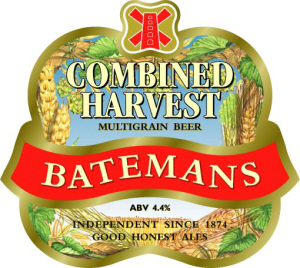 Batemans Combined Harvest Multigrain Beer Top Tastings 2012
ABV: 4.4%
Origin: Wainfleet, Lincolnshire, England
Website: www.bateman.co.uk
Under its picturesque disused windmill, Batemans has proved one of England’s more enduring and adaptable independent breweries since half the Bateman family took the leap of faith necessary to buy out the other half and keep the brewery open back in the 1980s. Sales of solid traditional cask bitters like XB and XXXB may be declining, but the brewery has compensated by introducing new styles and specials, both in cask and in attractively packaged bottles for supermarkets and export.
Combined Harvest is once such novelty. Head brewer Martin Cullimore set out specifically to experiment with several different brewing grains when he created it for the bottled market in 2001, including malted oats, rye and wheat in the grist as well as barley.
The bottled beer proved a notable success, winning a gold medal at the International Beer and Cider Awards in 2002 and being selected for inclusion in the book 1001 Beers You Must Try Before You Die. A cask version now appears as an occasional special, at a lower gravity (the bottled beer is 4.7%) and with a single hop, Challenger, at a modest IBU rating of 32.
It was the cask version that proved to be one of my pleasant beer surprises of the year when I happened upon it in top condition at a suburban Wetherspoon – a truly unusual and very complex beer that’s packed with flavour for a modest gravity.
The pale copper beer had a bubbly yellowish head and a very alluring aroma with fruit, slightly oily spice and malty cinder toffee. The palate was very full and complex with grainy rye bread notes, a touch of roast and vivid citrus hints emerging, the combination of grains yielding an intriguing mix of spicy dryness and firm sweetish malt.
A very smooth and nutty swallow was followed by a subtle and gentle but tasty and notably lasting finish, with orchard fruit and a gentle hop burr building to a light bitter bite.
You can read more about the brewery in a useful and relatively recent writeup by Roger Protz.
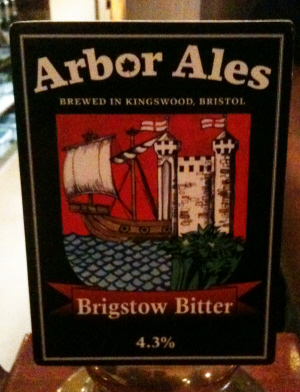 Arbor Ales Brigstow Bitter. Pic: Wonker – Creative Commons Top Tastings 2012
ABV: 4.3%
Origin: Bristol, England
Website: arborales.co.uk
Bristol is one of Britain’s more exciting beer cities at the moment, with some outstanding pubs, a small but growing cluster of decent small breweries and a flourishing homebrew scene. Besides Bath Ales, actually now much closer to Bristol than Bath and a well established and successful micro with a small estate of well regarded pubs, the two names that most excite contemporary beer drinkers are Arbor Ales and the Bristol Beer Company.
I’ve enjoyed some excellent and innovative beers from both brewers but it was Arbor that particularly stood out for me when I found myself in the city in September 2012 as a judge in the UK National Homebrew Competition. The night before I spent some time in Arbor’s pleasant brewery tap, the Three Tuns, where unsurprisingly I bumped into a few of my fellow judges.
Arbor was founded in 2007 by brewer Jon Corner with Megan Oliver in a small space behind the Old Tavern in Stapleton, northeast Bristol. A year later that pub closed and the brewery upgraded to a 10hl kit on an industrial estate in Kingswood, moving again early in 2012 to inner city Upper Easton.
Jon is known for his contemporary hoppy pale ales and ‘Freestyle Fridays’ rarities but the beer that most impressed me was the brewery’s take on a traditional English brown bitter, Brigstow. It’s made with exclusively English hops – Challenger for bitterness and substantial amounts of Fuggles and East Kent Goldings – with crystal malt and caramalt giving a firm backbone.
My pint from the cask at the Three Tuns was a warm amber colour with an orangey-beige head and a smooth, very chaffy and classic aroma with leafy hops. The palate, too, had that chaffy cereal and hopsack character, with clean malt, distinctive autumn fruit and orange notes, honey and bittering citrus.
A spicy swallow set up a hop-dominated finish with a solid grainy backdrop, with pithy grapefruit bitterness and earthy vegetal notes balanced by honey and biscuit.
Much as I’m delighted at the spirit of adventure sweeping many of the newer British microbreweries, it’s also reassuring to know that the future of the more traditional easy drinking styles of ale is in good hands.
 Anchor Brewing Company, Mariposa Street, San Francisco, California 94107 Top Tastings 2012 (Porter)
ABV: 6%, 5.6% and 5%
Origin: San Francisco, California, USA
Website: www.anchorbrewing.com
Despite numerous visits to San Francisco in recent years I hadn’t yet got round to visiting the famous Anchor brewery – arguably the motherlode of the current craft beer revival. I put that right in October 2012, joining a brewery tour and spending some time in the excellent company of head brewer Mark Carpenter.
Mark is something of a brewing legend himself. He’s been with the company, now based just below the summit of Potrero Hill in the east of the city, since 1971 and is now essentially the keeper of the flame since Fritz Maytag, who famously rescued Anchor and its unique Steam Beer in 1965, sold it on to two former executives of SKYY vodka in 2010.
I plan to write up that encounter in more detail at a later date, but the visit also proved a perfect opportunity to catch up on Anchor’s current range in the convivial tasting room next to the brewhouse, and remind myself of just how excellent it is. All the beers were tasted on keg as free samples.
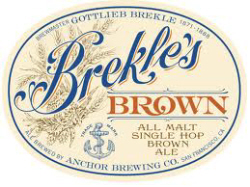 Anchor Brekle’s Brown Brekle’s Brown, launched in 2010 shortly after Fritz’s departure, is the first beer for which Mark was entirely responsible. Like many other Anchor products, it nods to earlier brewing practice. Gottlieb Brekle was a German immigrant who founded what would later become the Anchor brewery in a saloon near Russian Hill in 1871.
Back then, brown malts would have been the most easily available brewing grains and this robust contemporary take on the style nods to the past by including Munich and caramel malt alongside two-row pale to create a rich brown tone topped by a dense orange-tinged head.
I detected a very slight diacetyl note on a gritty malt-dominated aroma, also yielding citric notes from Citra, the single hop used. A lively palate began with toffeeish, slightly sugary malt, developing tingly hops, fresh citrus, orange marmalade and menthol-like spice.
The smooth finish turned lightly toasty with bitterish hop and cough candy notes. Overall this beautifully put together beer has proved a worthy addition to an already strong range, with the well judged use of Citra helping create a beer where fresh and juicy fruit flavours add drinkability and moreishness to a rich and chewy malt base.
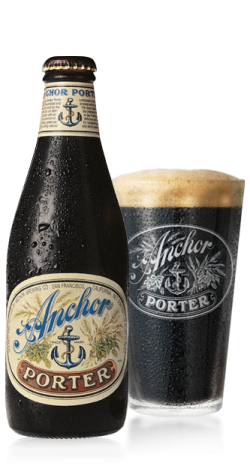 Anchor Porter Having saved steam beer from extinction, Fritz next turned to the resurrection of one of brewing’s great lost styles. Anchor Porter, the brewery’s second beer, first appeared in 1972. Almost certainly it was the first commercial example of a warm fermented porter created since the extinction of the style in Britain in the 1950s, and it made a vital contribution to reinstating porter, which had led the large scale industrialisation of brewing in 18th century London, to the vocabulary of world beer.
Anchor Porter happily remains a benchmark, a beer that’s both serious and approachable. The recipe is little changed since the 1970s – caramel, black and chocolate malts alongside pale to create a near-black colour, with a single hop, Northern Brewer in whole leaf form, for a vintage earthy British character.
A generous foamy and lacy light brown head yielded a very rich and roasty chocolate orange aroma with a hint of brown sugar and a dash of citrus zest. The roasty, grainy chaffy palate had hints of liquroice and caramel with a slightly medicinal, humbuggy note and earthy hop bitterness rumbling beneath. The swallow left a mouthful of smooth, malty, roasty flavour, with light coffee and herbal hints.
Overall the beer was the epitome of that perfect balancing act the best brewers achieve so well, with a deep dusky richness and a rewarding intensity of flavour that stops short of becoming overbearing. It’s one of many remarkable things about Anchor that a beer conceived as one of a kind four decades ago has proved difficult to equal ever since, despite the subsequent proliferation of competitors that Anchor itself helped inspire.
Read an earlier review of Anchor Porter.
It’s a challenge to pick just three featured beers from this brewery when there are so many good ones – Fritz’s second new beer, barley wine Old Foghorn, also remains a classic – but I couldn’t bring myself to leave out the beer that started it all.
 Glimpsed through the glass: shallow steam beer fermenters at Anchor, San Francisco. Steam beer was a response by German brewers schooled in lager techniques to the primitive facilities and mild climate of Gold Rush-era San Francisco. Lack of refrigeration meant cold fermenting yeast strains had somehow to be used at warm temperatures. Broad, shallow fermenting vessels, rather similar to the koelschepen employed in lambic brewing, were a partial solution as the greater surface area permitted more rapid cooling, but the action of the yeast at uncomfortably high temperatures induced a particularly high carbonation and a distinctive flavour.
The origin of the term is uncertain – Anchor claims it referred to the steam given off when hot wort was exposed to the city’s characteristically cool ocean breezes. The brewery retains traditional shallow fermenters just for making steam beer, though they’re no longer exposed to the vagaries of the city’s atmosphere. Instead they’re locked in an airtight room, spotlessly clean and temperature controlled with filtered air, though clearly visible through thick glass.
Steam beer was once San Francisco’s everyday beer, a cheap blue collar refresher flowing from numerous breweries, but Prohibition put paid to almost all of them and by the 1960s Anchor was its last remaining exponent. Fritz Maytag trademarked the term, which is why subsequent revivalist essays in the style by other brewers are obliged to use the post hoc style designation California Common.
Anchor Steam Beer today is a deep golden-amber beer with a sunburst glow created by darkening pale malt slightly with caramalt, and a light, faintly yellowish tinged head. My sample had a crisp, grainy and slightly toffeeish aroma, and a prickly and carbonated but very easy drinking palate with a traditional hop burr – as with the porter, Northern Brewer is the only variety used.
Subtle spice and hint of fruit – an artifact of the hybrid fermentation method – added interest and the beer finished almost pilsner-like, with light hops and a slightly nutty but very rounded chewiness. Another example of the art of balance, it remains a well made and very drinkable beer.
All the brewery’s beers are flash pasteurised – a disappointment to some purists, but something for which Mark is unapologetic. When Fritz first got involved, bad hygiene and the attendant lack of quality and consistency was one of the first challenges he faced, and the priority he gave to cleanliness and reliability remains deeply embedded in the brewery’s tradition.
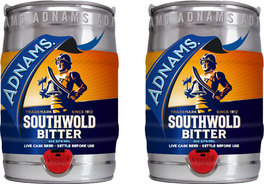 Adnams Southwold Bitter in minicasks. Pic: Adnams. Top Tastings 2012
ABV: 3.7%
Origin: Southwold, Suffolk, England
Website: adnams.co.uk
I’ve long regarded Adnams Southwold Bitter as one of the benchmark examples of a traditional English cask bitter, an outstanding demonstration of the genius of the best old estabished British breweries for achieving depth and complexity of flavour in a low gravity beer while retaining easy going drinkability.
Interestingly, it was only introduced in its current form as a “best” bitter in 1967, though six years later Frank Baillie in his survey of British brewing The Beer Drinker’s Companion is already describing it as “ a very distinct flavoured and popular draught bitter”. In my own early days as a real ale drinker in the late 1970s and early 1980s I looked forward to the rare occasions when it would find its way to my local free house.
Over three decades on, it’s still holding up and indeed on particularly good form in the hands of current head brewer Fergus Fitzgerald. Irish-born Fergus has proved an impressive custodian of the Southwold brewery’s tradition, while also steering it into more contemporary styles. The bitter is still brewed with strictly old school ingredients – East Anglian pale and crystal barley malts, with Fuggles the featured hop, both in a late addition and in dry hopping.
On cask in top condition, it’s a clear, deep amber beer with a bubbly white head and a delicate aroma combining chaffy light malt notes, stewed fruit and subtle spicy hops. The palate is notably dry – perhaps very slightly astringent – but develops impressive complexity, with twiggy spice, marmalade notes and a slightly salty, almost seaweedy touch. Some writers have romantically suggested a whiff of sea air from the brewery’s coastal location.
A chewy, lasting, lightly tart finish has a bit more salt alongside tobacco and more marmalade, with a distinct but controlled peppery bitterness emerging from the hops.
The bottled version, at a higher strength of 4.1%, is filtered and to me lacks the delicacy of the draught, but what really caught my attention in 2012 was the minicask version, which I discovered when researching a piece for Beers of the World about draught beer for the home. It’s essentially the same beer as the pub version, at the same ABV, but conveniently packaged for domestic use.
For those unfamilar with the format, minicasks – or easyKeg ITs as they’re termed by their German manufacturer Huber – are rugged 25cm tall waisted tinplate containers with a 5l capacity, looking much like a miniature version of a real cask stood on end, with a neat pullout tap near the base and an additional reclosable vent at the top.
They were originally intended for filtered German-style beers intended to be drunk quickly at events and parties, and the vent was provided as the simplest way to let air in so the beer could get out. But they have also turned out to be an ideal way of packaging cask conditioned beer for home use, allowing controllable venting like the bung and spile arrangement in a full sized cask.
Adnams has offered minicasks since 2010 as one of a growing number of British brewers adopting the technology to open up a new home drinking market. At first the products were very much a minor sideline, with a few filled by hand alongside conventional casks for the trade. Now demand has rocketed so much the brewery has invested in special equipment for filling them.
“It’s been phenomenal,” Fergus told me. “We sold 30,000 minicasks in 2011 and we easily expect to get past that this year. People are drinking more at home, and they’re also drinking more flavoursome beers, so we expect demand to keep on growing.”
Like their bigger brothers in the trade, minicasks come with a ritual attached, which Fergus sees as part of their charm. They need to be left to settle after transport, then vented, and left to stand for a further 24 hours before the first pint is poured. Once opened the contents should be consumed within three to five days.
“It’s an education,” said Fergus. “Having to look after a minicask helps people to understand more about cask beer as a live product, which helps their appreciation in the pub too.”
To demonstrate, he sent me a minicask of Southwold Bitter on which I lavished due care, venting it with a reassuring hiss and cooling it to something like cellar temperature with that old lo-tech standby, the wet towel.
I was rewarded with a fine looking pint sporting a creamy, lacy head, and all the chaffy freshness and spicy, fruity, marmalade-tinged complexity on the aroma that I’d expect in a pub with a top class cellar, with the smooth, gentle, easy condition of a proper cask beer.
The refreshing palate was packed with earthy, fruity flavour, leading to a smooth and lightly roasty finish, with a good balance of crystal malts and resinous Fuggles leaving lingering pepper, charcoal and even light chocolate notes.
While pub campaigners might bemoan the minicask and similar systems as yet another threat to the beleaguered on-trade, as a drinker I can’t help but be delighted that beer of such quality is now available for dispense in my own kitchen.
|
Cask  This pioneering new book explains what makes cask beer so special, and explores its past, present and future. Order now from CAMRA Books. Read more here. This pioneering new book explains what makes cask beer so special, and explores its past, present and future. Order now from CAMRA Books. Read more here.
London’s Best Beer  The fully updated 3rd edition of my essential award-winning guide to London’s vibrant beer scene is available now from CAMRA Books. Read more here. The fully updated 3rd edition of my essential award-winning guide to London’s vibrant beer scene is available now from CAMRA Books. Read more here.
|


















